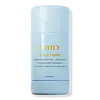What's inside
What's inside
 Key Ingredients
Key Ingredients

 Benefits
Benefits

 Concerns
Concerns

 Ingredients Side-by-side
Ingredients Side-by-side

Caprylic/Capric Triglyceride
MaskingCocos Nucifera Oil
MaskingTapioca Starch
Stearyl Alcohol
EmollientMagnesium Hydroxide
AbsorbentParfum
MaskingHydrogenated Castor Oil
EmollientOryza Sativa Bran Wax
Skin ConditioningBehenyl Alcohol
EmollientPolyglyceryl-3 Stearate
EmulsifyingMandelic Acid
AntimicrobialXylityl Sesquicaprylate
AntimicrobialAnhydroxylitol
HumectantMangifera Indica Seed Butter
Skin ConditioningPlatonia Insignis Seed Butter
EmollientTocopherol
AntioxidantCaprylic/Capric Triglyceride, Cocos Nucifera Oil, Tapioca Starch, Stearyl Alcohol, Magnesium Hydroxide, Parfum, Hydrogenated Castor Oil, Oryza Sativa Bran Wax, Behenyl Alcohol, Polyglyceryl-3 Stearate, Mandelic Acid, Xylityl Sesquicaprylate, Anhydroxylitol, Mangifera Indica Seed Butter, Platonia Insignis Seed Butter, Tocopherol
Aluminum Zirconium Tetrachlorohydrex Gly 15.4%
AstringentCyclopentasiloxane
EmollientStearyl Alcohol
EmollientHydrogenated Castor Oil
EmollientPPG-14 Butyl Ether
Skin ConditioningDimethicone
EmollientTalc
AbrasiveParfum
MaskingSilica
AbrasivePEG-8 Distearate
EmulsifyingAllantoin
Skin ConditioningMaltodextrin
AbsorbentCorn Starch Modified
AbsorbentBHT
AntioxidantAlpha-Isomethyl Ionone
PerfumingBenzyl Benzoate
AntimicrobialCitronellol
PerfumingCoumarin
PerfumingGeraniol
PerfumingHexyl Cinnamal
PerfumingHydroxycitronellal
PerfumingIsoeugenol
PerfumingLinalool
PerfumingAluminum Zirconium Tetrachlorohydrex Gly 15.4%, Cyclopentasiloxane, Stearyl Alcohol, Hydrogenated Castor Oil, PPG-14 Butyl Ether, Dimethicone, Talc, Parfum, Silica, PEG-8 Distearate, Allantoin, Maltodextrin, Corn Starch Modified, BHT, Alpha-Isomethyl Ionone, Benzyl Benzoate, Citronellol, Coumarin, Geraniol, Hexyl Cinnamal, Hydroxycitronellal, Isoeugenol, Linalool
Ingredients Explained
These ingredients are found in both products.
Ingredients higher up in an ingredient list are typically present in a larger amount.
Hydrogenated Castor Oil is created by adding hydrogen to castor oil. This helps stabilize the castor oil and raises the melting point. At room temperature, hydrogenated castor oil is solid.
Castor Oil helps moisturize the skin. It is rich in a fatty acid called ricinoleic acid. This fatty acid helps prevent moisture loss on the skin. This helps keep your skin soft and hydrated. Ricinoleic acid also has anti-inflammatory and pain reducing properties.
As a wax-like substance, Hydrogenated Castor Oil acts as an emollient. Emollients help keep your skin stay soft and smooth by creating a barrier. This barrier helps trap moisture.
Hydrogenated Castor Oil may not be fungal-acne safe. We recommend speaking with a professional.
Learn more about Hydrogenated Castor OilParfum is a catch-all term for an ingredient or more that is used to give a scent to products.
Also called "fragrance", this ingredient can be a blend of hundreds of chemicals or plant oils. This means every product with "fragrance" or "parfum" in the ingredients list is a different mixture.
For instance, Habanolide is a proprietary trade name for a specific aroma chemical. When used as a fragrance ingredient in cosmetics, most aroma chemicals fall under the broad labeling category of “FRAGRANCE” or “PARFUM” according to EU and US regulations.
The term 'parfum' or 'fragrance' is not regulated in many countries. In many cases, it is up to the brand to define this term.
For instance, many brands choose to label themselves as "fragrance-free" because they are not using synthetic fragrances. However, their products may still contain ingredients such as essential oils that are considered a fragrance by INCI standards.
One example is Calendula flower extract. Calendula is an essential oil that still imparts a scent or 'fragrance'.
Depending on the blend, the ingredients in the mixture can cause allergies and sensitivities on the skin. Some ingredients that are known EU allergens include linalool and citronellol.
Parfum can also be used to mask or cover an unpleasant scent.
The bottom line is: not all fragrances/parfum/ingredients are created equally. If you are worried about fragrances, we recommend taking a closer look at an ingredient. And of course, we always recommend speaking with a professional.
Learn more about ParfumStearyl Alcohol is a type of fatty alcohol from stearic acid. It is a white, waxy compound used to emulsify ingredients.
Fatty Alcohols are most often used as an emollient or to thicken a product. Emollients help soothe and hydrate the skin by trapping moisture.
They are usually derived from natural fats and oils and therefore do not have the same drying or irritating effect as solvent alcohols. FDA allows products labeled "alcohol-free" to have fatty alcohols.
Learn more about Stearyl Alcohol